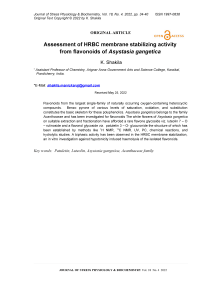Assessment of HRBC membrane stabilizing activity from flavonoids of asystasia gangetica
Автор: Shakila K.
Журнал: Журнал стресс-физиологии и биохимии @jspb
Статья в выпуске: 4 т.18, 2022 года.
Бесплатный доступ
Flavonoids from the largest single-family of naturally occurring oxygen-containing heterocyclic compounds. Benzo pyrone of various levels of saturation, oxidation, and substitution constitutes the basic skeleton for these polyphenolics. Asystasia gangetica belongs to the family Acanthaceae and has been investigated for flavonoids The white flowers of Asystasia gangetica on suitable extraction and fractionation have afforded a rare flavone glycoside viz. luteolin 7 - O - rutinoside and a flavonol glycoside viz. patuletin 3 - O- glucuronide the structure of which has been established by methods like 1H NMR, 13C NMR, UV, PC, chemical reactions, and hydrolytic studies. A biphasic activity has been observed in the HRBC membrane stabilization, an in vitro investigation against hypotonicity induced haemolysis of the isolated flavonoids.
Patuletin, luteolin, asystasia gangetica, acanthaceae family
Короткий адрес: https://sciup.org/143179363
IDR: 143179363
Список литературы Assessment of HRBC membrane stabilizing activity from flavonoids of asystasia gangetica
- Andersen, O. M., & Markham, K. R. (Eds.). (2005). Flavonoids: chemistry, Biochemistry and applications. CRC Press. https://doi.org/10.1201/9781420039443.
- Campos, C. C. Z.-, García-Martínez, J. E., Chavira, J. S., Valdés, J. A. A., Morales, M. A. M., & Mellado, M. (2020). Chemical composition and nutritional value of leaves and pods of Leucaena leucocephala, Prosopis laevigata and Acacia farnesiana in a xerophilous shrubland. Emirates Journal of Food and Agriculture, 723. https://doi.org/10.9755/ejfa.2020.v32.i10.2148.
- Chanbi, E., Devi, J., Kalita, P., Talukdar, N., Bhattacharjee, M., & Sarma, M. (2015). Journal of Forensic Toxicology & Pharmacology Phytochemical Analysis of Solanum virginianum and its Effect on Human Pathogenic Microbes with Special Emphasis on Salmonella typhi. Journal of Forensic Toxicology & Pharmacology, 4. https://doi.org/10.4172/2325-9841.1000141.
- Geissmann, T. A. (Ed.). (1962). The Chemistry of Flavonoid Compounds (Vol. 100). Pergamon Press, pp. 107. https://doi.org/10.1002/jpln.19631000113.
- Gopal, T., K., Megha, G., Chamundeeswari, D. and Reddy, C., U. (2013). Phytochemical and pharmacological studies on the whole plant of Asystasia gangetica. Indian Journal of Research in Pharmacy and Biotechnology, 1(3): 365-370.
- Harborne, J. B., & Williams, C. A. (2000). Advances in flavonoid research since 1992. Phytochemistry, 55(6), 481-504. https://doi.org/10.1016/S0031-9422(00)00235-1.
- Harborne, J. B., Mabry, T. J., & Mabry, H. (Eds.). (1975). Geissman T.A. and Hinreiner E in The Flavonoids. Chapman and Hall. https://doi.org/10.1007/978-1-4899-2909-9.
- HEMA, K. H., Ganana Rani, S. V., & Kumar, G. P. (2022). In-Vitro Anti-Inflammatory Studies of Flavonoids from Hibiscus Rosa-Sinensis Linn. Oriental Journal Of Chemistry, 38(1), 207-210. https://doi.org/10.13005/ojc/380127.
- Isna Athirah Othman, Norizan Ahmat, Amjad Ayad Qatran Al-Khdhairawi (2020). IRIDOID GLYCOSIDES AND PHENYLPROPANOIDS FROM Asystasia gangetica (L) T. ANDERSON VAR. Micrantha (ACANTHACEAE). Malayasian Journal of Analytical Scince (MJAS), 24(4): 530537.
- Mounnissamy, V. M., Kavimani, S., Balu, V., & Quine, S. darlin. (2008). Evaluation of Anti-inflammatory and Membrane stabilizing property of Ethanol Extract of Cansjera rheedii J. Gmelin (Opiliaceae). Iranian Journal of Pharmacology & Therapeutics, 6, 235237.
- Muthu Lakshmi. A, Padma Parvathi. R, & Prakash. R. (2019). Antioxidant Activity Evaluation of Hygrophyila Auriculata and Azima Tetracantha Extracts by An Electrochemical Method. Journal of Emerging Technologies and Innovative Research, 6(3). https://doi.org/10.6084/m9.jetir.JETIRAL06002
- Rosler, H., Mabry, T. J., Cranmer, M. F., & Kagan, J. (1965). The Nuclear Magnetic Resonance Analysis of the Disaccharide in Flavonoid Rhamnoglucosides. The Journal of Organic Chemistry, 30(12), 4346-4349. https://doi.org/10.1021/jo01023a525.
- Saleem, T. M., Azeem, A., Dilip, C., Sankar, C., Prasanth, N., & Duraisami, R. (2011). Anti-inflammatory activity of the leaf extacts of Gendarussa vulgaris Nees. Asian Pacific Journal of Tropical Biomedicine, 1(2), 147-149. https://doi.org/10.1016/S2221-169K1D60014-2.
- Simoni, R. D., Hill, R. L., & Vaughan, M. (2002). Analytical Biochemistry: the Work of Otto Knuf Olof Folin on Blood Analysis. Journal of Biological Chemistry, 277(20), 19-20. https://doi.org/10.1016/S0021-9258(20)85330-7.
- Thais Paula RodriguesGongalves, Adriano GuimaraesParreira, Vanessa Samudio dos SantosZanuncio, Katyuce de SouzaFarias, Denise Brentan daSilva, & Luciana Alves Rodrigues dos SantosLima. (2022). Antibacterial and antioxidant properties of flowers from Tecoma stans (L.) Juss. ex Kunth (Bignoniaceae). South African Journal of Botany, 144, 156-165. https://doi.org/10.1016/j.sajb.2021.08.028


